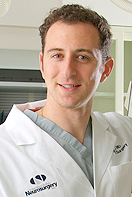Close Up
A rising star in neurosurgery
-
 Print
Print -
 Comments
Comments
-

Photo: DOUGLAS LEVERE
“I thought it was a field where there was an opportunity to make an impact.”
Elad Levy sits in the control room of the neuroendovascular suite in Millard Fillmore Gates Circle Hospital, dressed in blue scrubs. It is 8:45 a.m. on a recent Monday morning. Outside, Delaware Avenue is humming with traffic, with commuters on their way to work. Inside, Levy, a neurosurgeon and UB faculty member, has already been on the job for about two hours, supervising medical fellows and residents as they perform a post-operative angiogram to inspect a repair they had completed the previous night on a patient’s bleeding aneurysm. In exchanges with his fellow doctors, Levy is energetic but laid back—easygoing, one might say, for a man whose work week often tops 100 hours.
While long days are no anomaly in the world of medicine, Levy stands out as tireless even among physicians. At 37 years old, his CV is a dense 55 pages long. An associate professor of neurosurgery and a clinical associate professor of radiology at UB, Levy is listed as the first author on more than three dozen articles published in peer-reviewed journals and as a co-author on upwards of 100 more. He helped treat Buffalo Bills player Kevin Everett, who suffered a severe spinal cord injury on the field, and pioneered a method for performing minimally invasive spinal surgery in the U.S. At the August groundbreaking for UB and Kaleida Health’s 10-story global vascular institute and research building, L. Nelson Hopkins, a world-renowned neurosurgeon who chairs UB’s Department of Neurosurgery, singled out Levy, who will be relocating to the new facility, as a rising star.
“I think he’s one of the most exciting young neurosurgeons that I’ve ever come across,” Hopkins says. “We’ve got a lot of great, great guys in our department, and Elad is one of them. He has, at an incredibly young age, achieved an enormous amount.”
While many medical students struggle to choose a specialty, Levy knew by the end of his first year in medical school that his interest lay in neurosurgery, which focuses on the treatment of diseases and conditions affecting the nervous system, including the brain and spine. He first learned about the field through his mentor, Laligam Sekhar, then chair of the neurosurgery department at George Washington University in Washington, D.C., where Levy was studying.
“I thought it was very challenging, and I always like challenges,” Levy says. “I thought it was very diverse. From a technical standpoint, you get to do microscopic surgery, a very fine manual skill, but you also get to do macrosurgery—when you’re operating on the spine, for instance. And the fact that we know so little about the brain—I thought it was a field where there was an opportunity to make an impact.”
After graduating from the George Washington University School of Medicine in 1997, Levy did a yearlong surgical internship at the University of Pittsburgh, followed by a six-year neurosurgical residency there. While training at Pittsburgh, he also completed a two-year fellowship at UB in endovascular surgery, which involves using X-ray and other imaging technology to guide small tubes and devices through blood vessels to access and treat abnormalities within the body, such as aneurysms and vascular tumors.
In 2004, Levy returned to Buffalo to take a full-time faculty position at UB. Today, his interests within neurosurgery vary. He is working with aerospace engineers to better understand blood flow patterns, which share some characteristics with air flows and can, when abnormal, lead to strokes. He and colleagues earned FDA approval for the first prospective trial to test the usage of stents in the human brain to prevent acute ischemic strokes.
Levy is also a specialist in minimally invasive neurosurgery. In 2005, he performed the first U.S. surgery using axial lumbar interbody fusion, a method of stabilizing the lumbar spine in patients experiencing back or leg pain. Neurosurgeons using the procedure create a 2-centimeter incision to the left of the tailbone and thread instruments, such as miniaturized scrapers and tiny drills, through the patient’s body along a guide wire to the surgery site. Minimally invasive techniques eliminate the need for large incisions and major anesthesia, enabling patients to recover more quickly.
“If I have any strengths, one of my strengths is foresight, and I knew that the field of neurosurgery would become increasingly minimally invasive,” Levy says. “We’re not going to be peeling down a person’s scalp and opening a hole in their skull when we can do (surgery) through a puncture.”
Levy’s wide-ranging knowledge and expertise, along with his vigor, have earned him the admiration of the young doctors with whom he works on a daily basis. Kenneth Snyder, chief resident in UB’s neurosurgery department, calls Levy a “superb teacher.”
“He often accomplishes more in a day than most people do in a week, and I would also say he has a very, very tight family,” Snyder says. “He’s an excellent example of a good husband, constantly prioritizing his family as well.
“In terms of residents,” Snyder says, “we can’t keep up with him.”

Reader Comments